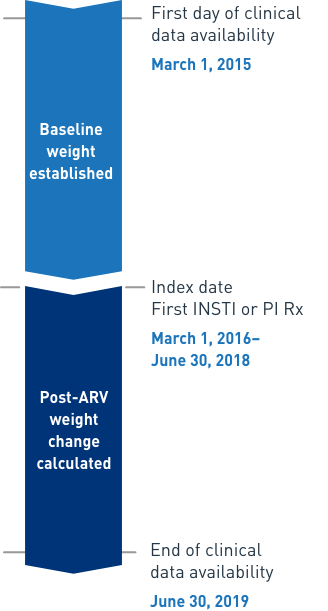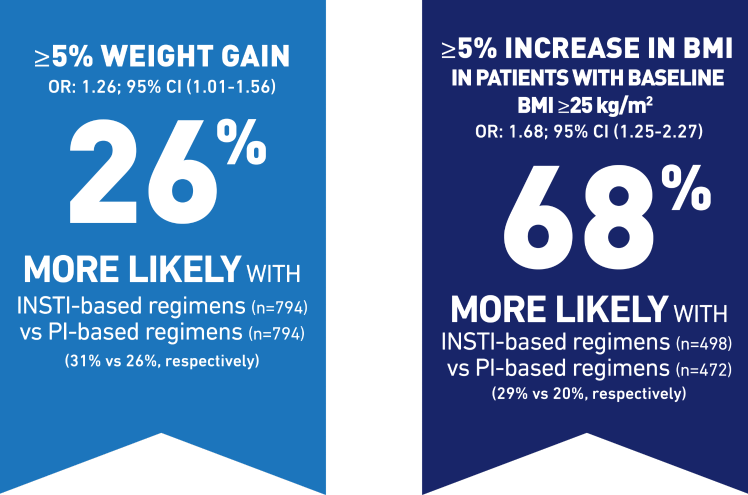Consistent with findings in the DHHS guidelines
Differences in ARV-Related Weight Gain Supported by Real-World Evidence1
Study Design: Real-World Assessment of Weight Change in People With HIV-12


This retrospective, observational cohort study of adult PLWHIV who initiated INSTI- or PI-based regimens included data from the Optum® de-identified EHR database. This database includes patient-level records containing de-identified longitudinal data for 80 million US patients (≥7 million patients from each census region). The database also includes information on outpatient visits, diagnostic procedures, medications, laboratory results, hospitalizations, clinical notes, and patient outcomes, primarily sourced from integrated delivery networks.
The primary outcomes were change in weight and BMI within 12 months post-initiation of INSTI- vs PI-based regimens in treatment-naïve male and female patients and in female patients alone. Change in weight and BMI from baseline measurement to follow-up measurement were reported as absolute change and percent change. Cohorts were balanced using PSM. Multivariable models were used to compare outcomes of interest (outcomes were also determined by index BMI value [<25 kg/m2 vs ≥25 kg/m2]).
Study limitations: EHRs do not necessarily indicate whether the patient received or took the medication. The first HIV diagnosis or prescription for ARV observed in the database may not correspond to the patient’s first diagnosis. Lastly, it was observed that a higher proportion of INSTI-based vs PI-based regimens included TAF (27.8% vs 2.4%), which has been associated with weight gain, especially in combination with INSTIs. Despite use of PSM analysis, the study was unable to determine the relative contribution of TAF vs INSTIs due to the small number of PI initiators whose regimen included TAF.
Results from a study of real-world evidence at 9.3 months mean follow-up2:


- Patients who received INSTI-based regimens experienced a 1.3 kg greater mean weight gain vs those who received PI-based regimens (1.8 kg vs 0.5 kg; 95% CI [0.5-2.0], respectively)
- Overall population results were consistent across multiple different endpoints
ARV=antiretroviral; BMI=body mass index; DHHS=Department of Health and Human Services; EHR=electronic health record; INSTI=integrase strand transfer inhibitor; PI=protease inhibitor; PLWHIV=people living with HIV; PSM=propensity score matching; TAF=tenofovir alafenamide.
References: 1. Department of Health and Human Services. Guidelines for the use of antiretroviral agents in adults and adolescents with HIV. Updated January 20, 2022. Accessed March 8, 2022. https://clinicalinfo.hiv.gov/en/guidelines/adult-and-adolescent-arv/whats-new-guidelines 2. Chen Y-W, Hardy H, Pericone CD, Chow W. Real-world assessment of weight change in people with HIV-1 after initiating integrase strand transfer inhibitors or protease inhibitors. JHEOR. 2020;7(2):102-110.
